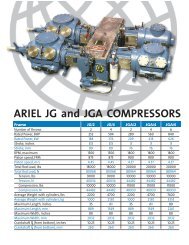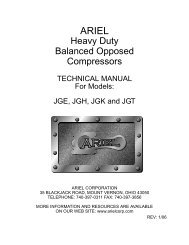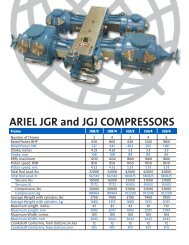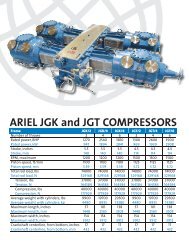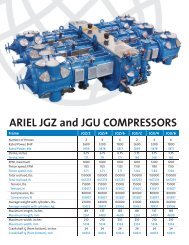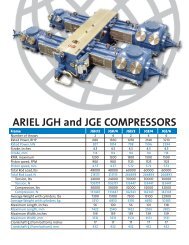Heavy Duty Balanced Opposed Compressors
Heavy Duty Balanced Opposed Compressors
Heavy Duty Balanced Opposed Compressors
Create successful ePaper yourself
Turn your PDF publications into a flip-book with our unique Google optimized e-Paper software.
FOR MODELS: JG AND JGA SECTION 5 - MAINTENANCE<br />
released, there should be no continuous stream of bubbles coming from the<br />
pressurized case.<br />
5 Cases which fail this testing procedure are to be disassembled, inspected,<br />
repaired, re-assembled and re-tested. Packing cases may be bolted into place<br />
in a cylinder head to aid sealing, using proper bolting and tightening torques.<br />
All cylinders with water-cooled packing must be connected to a circulating water cooling system<br />
that will provide the required flow, pressure drop, inlet temperature and heat rejection,<br />
unless prior approval is obtained from Ariel to leave it unconnected.<br />
Ethylene Glycol Contamination<br />
Ethylene glycol contamination of a compressor can result from water-cooled compressor rod<br />
packing or oil cooler.<br />
Ethylene glycol anti-freeze coolant mixture leaking into the compressor frame crankcase oil<br />
can cause crankshaft seizure due to lack of adequate lubrication. Crankcase oil should be<br />
changed as recommended in “Recommended Maintenance Intervals” on Page 6-1 Also,<br />
crankcase oil should be routinely sampled and analyzed by a qualified laboratory to verify<br />
suitability for continued use, including checking for ethylene glycol contamination.<br />
Even small quantities of ethylene glycol in the oil can be detrimental. If contamination is less<br />
than 5%, drain oil, replace filters and flush oil system with a 50-50 mixture of butoxyethanol<br />
(Dow Chemical Company Dowanol EB or equivalent) and 10W oil using a motor driven<br />
pump. Flushing should be done on a warm compressor. Bearings should be continuously<br />
flushed for 1/2 hour while barring over compressor. All surfaces that come in contact with<br />
crankcase oil are to be flushed, including spraying all interior surfaces in the crankcase.<br />
Completely drain cleaning mixture, being sure to drain all components of the oil system.<br />
Repeat flushing operation using a 60/40 mixture of 10W oil and kerosene or fuel oil. Completely<br />
drain the system, install new filters and fill the crankcase with proper oil. The source<br />
of the coolant leak must be found and repaired.<br />
If sampling indicates ethylene glycol contamination greater than 5% or if the compressor has<br />
seized due to contamination, the unit must be disassembled, cleaned with 100% butoxyethanol,<br />
flushed with kerosene or fuel oil and repaired as required. All surfaces that come in<br />
contact with crankcase oil must be cleaned with butoxyethanol, including all passages and<br />
piping, and then flushed with kerosene or fuel oil. Oil and filters must be changed. The<br />
source of the coolant leak must be found and repaired.<br />
Butoxyethanol presents health and safety hazards. Use proper eye and shin protection and<br />
adequate ventilation. Do not use near open flame or sparks. See manufacturer’s Material<br />
Safety Data Sheet for complete details.<br />
Ethylene glycol, butoxyethanol, contaminated oils and solvents must be properly disposed.<br />
A qualified chemical disposal service should be used.<br />
PAGE 5 - 38 11/01





